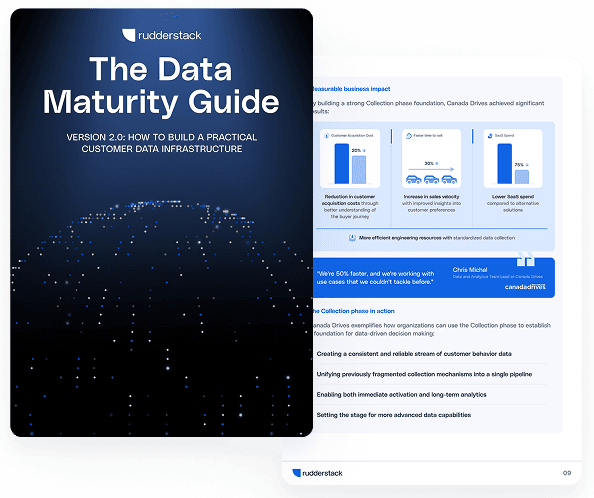From pricing to performance: How Bolt built a future-proof marketing data stack

At the ICOM Global Summit in Menorca, we sat down with Polina Shevchenko, Head of Marketing Technology and Measurement at Bolt, to discuss how her team approaches martech decisions, the role of customer data platforms in scaling operations, and what the future holds for AI in marketing.
For fast-growing companies, choosing the right marketing technology stack isn't just about solving today's problems—it's about building infrastructure that can scale and evolve with your business. That's exactly the challenge Polina Shevchenko faces as Head of Marketing Technology and Measurement at Bolt, where she's spent five and a half years helping the mobility platform scale its data operations across global markets.
The strategic/platform team approach
Polina's team at Bolt operates as what she calls a "strategic/platform team"—a central hub that ensures all marketing teams have access not just to the right tools, but to the best ones. As Polina put it, “we’re responsible for making sure we have the best tooling, the best know-how, the best frameworks for getting the most out of what we do.”
Rather than focusing on day-to-day operations, they tackle high-impact projects that create efficiency and scale for the business.
"Whatever we do provides a significant multiplier or makes changes in the business undeniable," Polina explains. "The goal is not just to understand, but to change the way decision-making is done."
In 2024, her team focused heavily on measurement, specifically building frameworks around incrementality testing to understand the true impact of marketing investments. But 2025 brought a different priority: improved efficiency through automation and AI.
"This year, we're focusing a lot on efficiency improvement," she says. "[We want to be sure] that we're doing the best work we can with the resources we have, so people are enabled to invest in meaningful activities."
The customer data tool evaluation: Beyond just features
When Bolt was evaluating customer data platforms in 2022, they already had a working solution in place. But as Polina puts it, having something that works isn't the same as having the best solution for your needs and budget. Bolt’s evaluation process included several factors.
The migration experience
Perhaps most importantly, Bolt needed confidence that switching tools wouldn't create months of chaos. "You are switching from certainty to uncertainty," Polina explains. The RudderStack team understood these concerns, and worked with Bolt to provide a comprehensive testing plan. "What we really appreciated is a very thorough demo experience—three months where we got to try with our real data, not just some fake demo account."
Integration capabilities
Bolt has numerous internal and external tools that teams already use, so a seamless integration was non-negotiable. "How well the tool can play with other tools that we have is important," Polina notes. "The easier it is, the better, because then people in our team can focus on something else."
RudderStack’s seamless integrations with over 200 downstream tools gave Polina and team confidence that it would be a smooth transition.
A big part of Polina’s job, as she told us, is to “future-proof” their integrations to avoid needing to reevaluate tools every couple of years. This includes evaluating the pricing structure to be sure it aligns with the company’s growth plans.
Pricing that scales with growth
When it comes to pricing, Polina notes that it’s about more than “just the price of the next contract." For a rapidly growing company like Bolt, understanding how pricing structures evolve with scale is crucial. "A lot of providers penalize you for growth, right? Bolt as a company, we are growing a lot every year. We need to account for that." RudderStack’s transparent, scalable pricing model aligned with Bolt’s needs.
RudderStack's role in Bolt's architecture
Today, RudderStack serves as a critical bridge in Bolt's data infrastructure, moving data from internal solutions to external platforms like Mixpanel, Google, and Facebook. But its value extends beyond simple data transfer.
Transformations for marketing flexibility
One of the most valuable features for Bolt is RudderStack Transformations. "Our common case is that in AppsFlyer, we want to see not just the total number of conversions, but the number of first-time conversions," Polina explains. "It's very easy to do this with Transformations."
This capability allows marketing teams to modify existing events without requiring engineering resources—a significant advantage for a growing company where engineering time is precious.
Reverse ETL for historical data
RudderStack's reverse ETL functionality provides another layer of flexibility. "A lot of data that we have doesn't necessarily trigger an event because no one needed it in the past," Polina says. "We can take this data from our database, pass it, transform it, and have events that are generated from our warehouse data."
This approach enables data analysts, who are already familiar with the data structure, to create the events they need without waiting for engineering support.
The AI revolution in marketing
As AI continues to dominate marketing conversations, Polina brings a refreshingly problem-first perspective to the discussion. "I always want to keep thinking about the problem first rather than the solution," she says. "We want to start with understanding what problems are and whether these new tools actually help us solve problems."
While acknowledging that AI will be "insanely transformational" for marketing, she draws important distinctions between traditional machine learning models that have been in use for years and the newer AI capabilities that can tackle previously difficult-to-automate tasks.
"AI allows us to take it one step further, especially for areas that previously were very heavy to simplify, automate, or scale up," she explains.
The democratization aspect particularly excites her team: "Now data analysts or maybe even marketing operations people can ask ChatGPT how to create an event, pass some examples from our library, and have it instantaneously instead of waiting several weeks for the engineering team to pick it up."
Advice for fellow martech leaders
When asked for advice for other heads of martech just starting to analyze their customer data infrastructure, Polina emphasizes the importance of balancing long-term thinking with practical needs.
"Think long term, but try to be very pragmatic," she advises. "You want to think about what your company will look like in a few years—in size, but also in terms of internal architecture."
The key is finding tools that can either evolve with your company's growth or partners that are growing in a similar direction. "No one enjoys jumping tools every couple of years. It's so much effort, so much pain," she says. "Finding the balance between having a great solution now and how you expect things to look in three to five years—that's the hard part, the exciting part, but also necessary."
Building for tomorrow, delivering today
Bolt's approach to marketing technology reflects a mature understanding of how fast-growing companies need to think about infrastructure investments. By focusing on tools that provide immediate value while scaling with business growth, they've built a foundation that supports both current operations and future ambitions.
As Polina's team continues to explore efficiency improvements and AI applications, their partnership with RudderStack exemplifies how the right customer data infrastructure can serve as more than just a data router—it becomes an enabler of marketing innovation and operational excellence.
Want to learn how RudderStack can help your team build a future-proof marketing data stack? Get in touch with our team to explore how we can support your growth journey.
Published:
July 1, 2025

Understanding event data: The foundation of your customer journey
Understanding your customers isn't just about knowing who they are—it's about understanding what they do. This is where clean, accurate event data becomes a foundational part of your business strategy.

How AI data integration transforms your data stack
This article breaks down what AI data integration means, explores key benefits like faster time-to-insight and improved data quality, and walks through practical use cases and implementation strategies.

Behavioral segmentation: Examples, benefits, and tools
In this guide, you'll learn how behavioral segmentation works, explore real-world examples, and discover the tools modern teams use to power it. You'll also learn how RudderStack helps unify behavioral data across your entire stack in real time.







